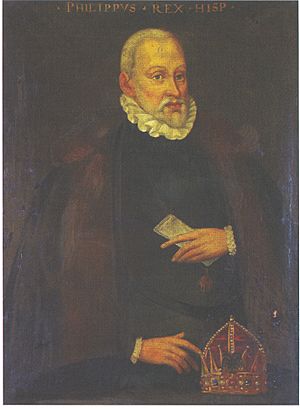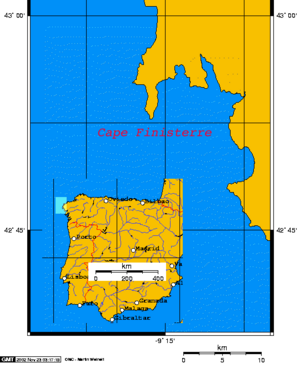2nd Spanish Armada facts for kids
Quick facts for kids 2nd Spanish Armada |
|||||||
|---|---|---|---|---|---|---|---|
| Part of the Anglo-Spanish War | |||||||
 Philip II of Spain in his old age, ordered the Armada of 1596 in revenge for the English attack on Cadiz |
|||||||
|
|||||||
| Belligerents | |||||||
| Commanders and leaders | |||||||
| Strength | |||||||
| Fleet 24 galleons 53 armed merchant ships Total 126 - 140 ships 19,500 men (approx.) |
Various shore defences 13 galleons 74 armed merchant vessels 12,000 men |
||||||
| Casualties and losses | |||||||
| 1 Flyboat captured Storms/Disease: 5 galleons sunk 38 other ships sunk or scuttled 5,000 dead |
Unknown | ||||||
The 2nd Spanish Armada was a large fleet of ships sent by King Philip II of Spain in 1596. Its main goal was to get revenge on England for attacking the Spanish city of Cadiz earlier that year. Philip also hoped to help Irish rebels who were fighting against the English.
This naval operation was part of the ongoing Anglo–Spanish War. The plan was to create a new battlefront in Ireland. This would force England to move its soldiers away from other conflicts in France and the Netherlands.
The Armada was led by Martín de Padilla. It gathered in Spanish ports like Lisbon and Vigo. However, soon after setting sail in October, severe storms hit the fleet near Cape Finisterre. The storms caused huge damage, forcing the ships to turn back. Around 5,000 men died from the storms or disease. About 38 ships were lost. This disaster meant the invasion plan had to be put off for a long time. It also caused big financial problems for Spain.
Why the Armada Sailed
Spain and England had been fighting for almost twelve years. Neither side was clearly winning. King Philip II of Spain had sent his forces to help Catholics in France. This meant Spanish troops were stationed along the French and Flemish coasts. These locations were very important because they allowed Spain to threaten England directly.
England, on the other hand, was helping the French King Henry IV. In 1596, Spain captured the French city of Calais. This made it seem easier for Spain to attack England. After this, England, the Dutch Republic, and France formed an alliance.
In the summer of 1596, an English fleet attacked Cadiz in Spain. English commanders Robert Devereux and Charles Howard led this attack. They captured and looted Cadiz for two weeks. King Philip II was very angry about this. He immediately wanted revenge, even if it meant spending all his money.
Some of Philip's advisors thought invading Ireland was a good idea. They believed it would weaken England. Marquis of Santa Cruz, an earlier Spanish commander, had suggested landing in Ireland in 1586. This plan was stopped then because of an English raid on Cadiz.
Philip II ordered Martín de Padilla to prepare a new fleet. The goal was to land in Ireland and support the rebellion led by Hugh O'Neill, Earl of Tyrone. O'Neill and another Irish leader, Hugh Roe O'Donnell, had asked Philip for help. They even offered to become his loyal subjects. Philip encouraged them to keep fighting and not make peace with England's Queen Elizabeth. Spain's strategy was simple: a war in Ireland would make England fight on a new front. This would draw English troops away from other battles.
The Spanish Fleet
King Philip II had high hopes for this new fleet, which was being put together in Lisbon. It included:
- 15 large warships called galleons from Castile.
- 9 galleons from Portugal.
- 53 merchant ships from Flanders and Germany.
- 6 smaller, fast ships called pinnaces.
- 1 caravel (a small, fast ship).
In total, there were about 10,790 men on these ships. Another 2,500 soldiers were to join from Seville. In the north, at Vigo, 41 more ships with about 6,000 men were waiting. The entire force led by Martín de Padilla had around 11,000 infantry (foot soldiers) and 3,000 cavalry (soldiers on horseback). There were also 5,500 sailors.
The main leaders, besides Padilla, were Carlos de Arellano, Sancho Martínez de Leyva, and Diego Brochero. Even before the fleet left, there were rumors in Spain that Spanish troops had already landed in Ireland.
Meanwhile, in England, spies and merchants sent reports to Queen Elizabeth. They said there were many ships in Lisbon and new warships being built. However, the Queen was told that the Spanish would not attack because of the expected autumn storms. Still, England prepared its navy. Reinforcements were sent to protect places like the Isle of Wight and Falmouth.
By early October, the Armada was still not ready to leave. There wasn't enough food or money, and some sailors were close to mutiny. This made King Philip very angry. He eventually canceled the plan to invade Ireland. The bad weather, the late season, and sickness among the crews were the reasons. Instead, Padilla was ordered to sail to La Coruña. From there, he was to try and capture the French port of Brest. Brest was chosen because it was closer to Spain and could be used as a base to attack England or help the Irish rebels.
The Storm and its Aftermath
On October 24, the weather finally improved, and 81 ships of the Armada left Lisbon. The fleet sailed towards La Coruña. They reached Viana do Castelo and waited for a good wind. When the wind came, they sailed near Cape Finisterre, the westernmost point of Spain. This was as far as they would get.
Suddenly, an unexpected storm hit the fleet. The ships that managed to get past the Cape were scattered across the Bay of Biscay. Many were so damaged they couldn't be repaired. The entire Spanish force was no longer an effective fighting fleet. Forty damaged ships, including Padilla's flagship San Pablo, managed to return to the port of Ferrol.
By November 1, most of the remaining fleet had returned. Padilla reported the disaster to King Philip, who was very sad.
In England, reports of the Armada sailing began to arrive. There were even rumors that 1,500 Spanish soldiers had landed in Ireland. Charles Howard sent a strong English fleet to find the Spanish Armada. They found only floating wreckage and bodies. However, they captured a Spanish ship and 200 of its crew. From them, the English learned the full extent of the Armada's disaster. None of the Spanish ships ever reached the English Channel. Brest, Ireland, and England were saved from a major attack.
At first, the damage seemed small, and Philip hoped the ships could be repaired. But as time passed, the true scale of the disaster became clear. Many ships were lost, and there was much sadness. Thirty ships were missing, and thirteen had crashed into reefs. Many important people from Portugal died. Five of the King's main warships, called the Apostles, were lost. The worst loss was the 900-ton galleon Santiago. It carried 330 soldiers and sailors, but only 23 survived. Disease had also spread through the ships while they were in port. In total, nearly 5,000 men died from shipwrecks or disease.
Because of the huge losses, Philip sadly canceled the invasion plan on November 13. The disaster was also a financial ruin. Two ships, La Capitana de Levante and Santiago, carried large amounts of money. These were lost. Philip had to declare that Spain was bankrupt for the third time during his reign. He desperately wanted to postpone the Armada, not cancel it completely. He had to borrow more money from his Italian territories.
Irish leaders who were living in exile still believed the Armada would come to Ireland. A year later, in 1597, Spain tried another invasion. This time, the plan was to attack England and destroy the English fleet returning from a failed voyage. This Armada of 1597 also faced a storm. Some ships managed to reach Cornwall and Wales, and some troops even landed. But most of the fleet was scattered, and the commander ordered them to retreat to Spain. They also lost more ships to the returning English fleet they had failed to destroy.
See also
 In Spanish: Armada española de intervención en Irlanda (1596) para niños
In Spanish: Armada española de intervención en Irlanda (1596) para niños



